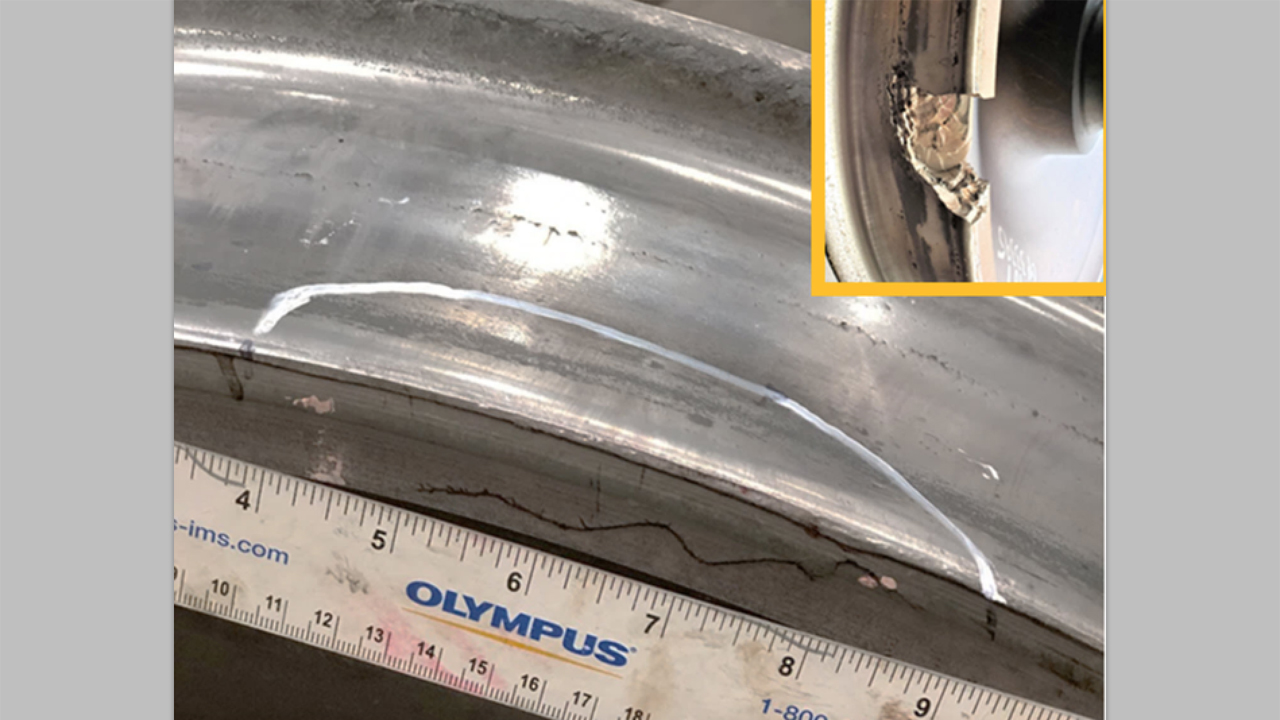
TTCI R&D: ACWDS Implementation
Written by Anish Poudel, Ph.D., Principal Investigator I (NDT), Transportation Technology Center, Inc.
A wheel with an internal crack detected by ACWDS before the wheel was removed from the FAST train. The inset photo is an example of a broken wheel that might result from such a defect.
RAILWAY AGE, JANUARY 2022 ISSUE: The Automated Cracked Wheel Detector System safely detects wheels with internal defects, without interrupting revenue service.
Transportation Technology Center, Inc. (TTCI) has concluded the research, development and testing of a Tycho-manufactured Automated Cracked Wheel Detector System (ACWDS) capable of inspecting wheels for internal fatigue cracks at speeds of up to 15 mph. The validation of the system, sponsored by the Association of American Railroads (AAR), was performed using the heavy axle load (HAL) test train (a consist of about 120 cars, each with a 39-ton axle load) at the Facility for Accelerated Service Testing (FAST) near Pueblo, Colo.
Wheel impact load detectors (WILD) effectively find out-of-round and shelled wheels, but by design, these detectors are not meant to find wheels with internal cracks that may lead to breaks. In fact, many broken wheels fail without ever indicating WILD-recorded high impact loads. Other vision- or laser-based systems can only find broken wheels after they fail. These systems are not designed to find internal fatigue cracks that are believed to be the precursor of broken wheels. Rails are tested ultrasonically for internal defects; currently, wheels are not tested in the same manner. The goal of the ACWDS is the safe detection of wheels with internal defects without interrupting revenue service.
The ACWDS evaluated at FAST is a wayside, ultrasonic, non-destructive evaluation (NDE) system that uses spring-loaded contact ultrasonic transducers to inspect moving train wheels for internal fatigue cracks in the tread, near the rim face and at the wheel flange. The trackwork uses a wide gage segment with inboard ultrasonic probes positioned at the wheel tapeline (center) and a standard gage segment with outboard ultrasonic probes placed on the field side of the wheel tread (near the rim face) to inspect the entire wheel tread. For a single pass, every wheel (38-inch diameter maximum) is inspected during two full revolutions of the wheel in the wide gage section and during one full revolution in the standard gage section. The use of multiple revolutions provides for a complete inspection of the wheel tread with 0-degree probes, as well as an inspection of both the flange and the rim with angled 70-degree probes. It should be noted that the 70-degree angled probes do not operate well above 5 mph, but 0-degree probes can operate at speeds up to 15 mph.
— Each ultrasonic probe inspects a sector of the wheel, and the individual inspections are seamed together. —
Each ultrasonic probe inspects a sector of the wheel, and the individual inspections are seamed together to provide a view of the wheel’s entire circumference. The system uses wheel flange speed sensors laid next to the ultrasonic probes to measure wheel speed and to synchronize the triggering of the ultrasonic probes with the arrival of the wheels. Additionally, the system uses transmitter/receiver pairs of photoelectric sensors to wake up and shut down the system as the train enters and exits. The Tycho ACWDS is also equipped with a self-diagnostic tool to help ensure continuous operation. When a probe malfunctions, the ACWDS acquisition software will notify the operator to replace the probe. Similarly, the ACWDS acquisition software will alert the operator if any ultrasonic hardware or data collection units, such as those inside the wayside cabinets, malfunction or fail to communicate properly. These systems performed as intended during TTCI’s evaluation.
During recent FAST operations, the train passed 12 times through the ACWDS, and 5,204 total wheelset inspections (10,408 wheels) were performed. ACWDS detected seven wheels with crack indications. All indications were later verified with hand-held ultrasonic testing (UT). To date, the verification hand-held UT scans have been in close agreement with the ACWDS findings. Some of the wheels with crack indications were tracked over time to gain insight into crack growth rates. The illustration on p. 40 shows a wheel with an internal crack that was detected by ACWDS before the wheel was removed from the FAST train. The inset photo is an example of a broken wheel that might result from such a defect. In addition, prior work attempted to estimate the false-negative rate with a hospital train (with all known wheel conditions).1 Subsequent updates and the addition of the outboard probes would address the previously missed detections. Despite the addition of these probes, inconsistent triggering of the system may still generate false negatives.
The research also revealed several operational events and associated recommendations.2 It is important to note the differences between testing the Tycho ACWDS with a single-unit train in a controlled environment and actual train operations in revenue service. For instance, while the FAST train ran through the Tycho ACWDS during TTCI’s evaluation, the quantity of wheels that will be scanned in an actual revenue service installation will be much higher. Consequently, the amount of observed wear on both the probes and the trackwork at FAST has been minimal and might not reflect performance in revenue service.
The ACWDS tested at FAST is relatively unprotected, so its maintenance requirements are both unique to its location and more complex than if the system were protected by a shelter building. Based on the lack of protection from the environment, frequent maintenance would be impractical in actual revenue service. Therefore, a design update along with regular system maintenance is recommended for any Tycho ACWDS installations. Determining the location of any system for revenue application should consider the specific environmental requirements.
References:
Poudel, A. and M. Witte. January 2017. “Automated Cracked Wheel Detection with Tycho ACWDS,” Technology Digest TD17-002, AAR/TTCI, Pueblo, Colo.
Poudel, A. and M. Witte. January 2017. “Tycho ACWDS Service Implementation,” Technology Digest TD21-001, AAR/TTCI, Pueblo, Colo.



